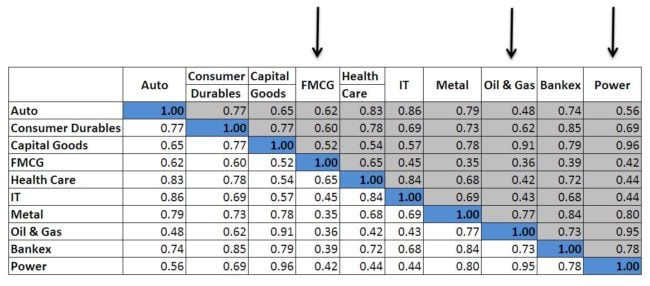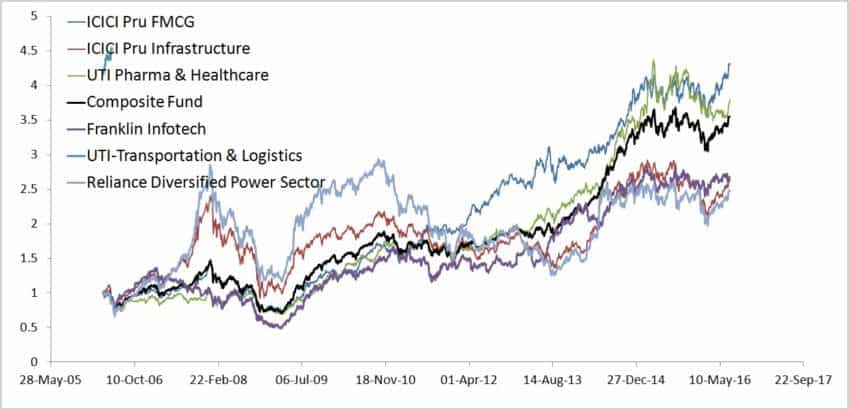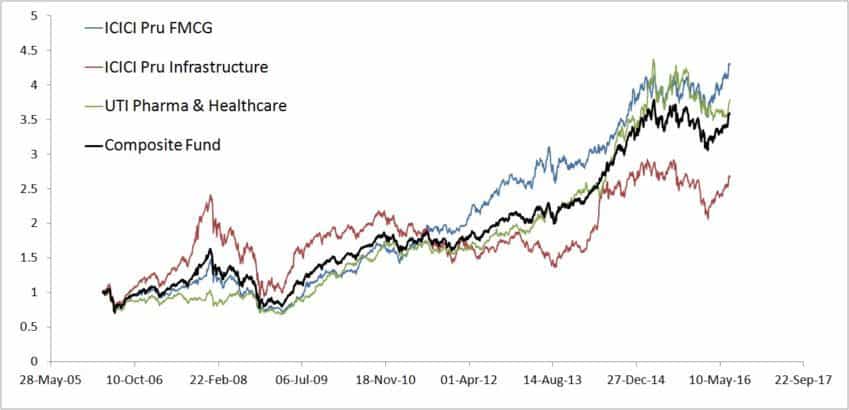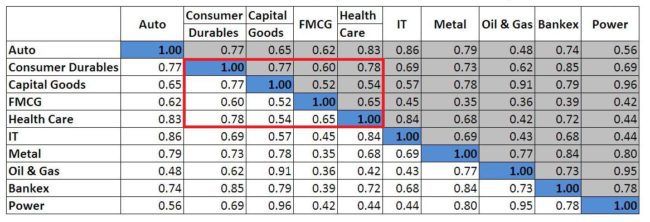Last Updated on December 18, 2021 at 10:33 pm
In the third part on portfolio diversification, we shall study the correlation among stock sectors. Part I covered the diversification among asset classes and market caps, and part II covered international equity indices.
Regular readers may recall that we already saw how to build a diversified equity portfolio with sector mutual funds. The mutual chosen for this study were randomly picked – oldest funds in the sector category listed by Value Research Online.
In this post we shall first study the correlation among stock indices and then choose some sector mutual funds and find out if we can be a little more methodical in choosing funds for such a portfolio.
Caution: Before we begin it would be best to remind ourselves as to why we are interested in sector mutual funds. It is not to choose the ‘hot’ fund and chase afters returns. It is to build a diversified portfolio with only sector funds so that the volatility of the portfolio is lowered.
Join 32,000+ readers and get free money management solutions delivered to your inbox! Subscribe to get posts via email! (Link takes you to our email sign-up form)
🔥Want to create a complete financial plan? Learn goal-based investing? Exclusive access to our DIY tools? Increase your income with your skills? Enjoy massive discounts on our robo-advisory tool & courses! 🔥
Correlations among equity sectors
To understand how different equity sectors are correlated, the following indices were chosen from BSE.
- Auto
- Consumer Durables
- Capital Goods
- FMCG
- Health Care
- IT
- Metal
- Oil & Gas
- Bankex
- Power
Returns of these indices were computed for every 1-year interval between 3rd Jan 2005 to 23rd Jun 2014 (data for the first 8 indices are available from Feb 1st 1999. BSE Power is the youngest index and was started on 3rd Jan. 2005).
What do we mean by measuring correlation?
We measure the correlation coefficient of the 1-year interval. This is a measure how the movement of one index affects the other. This is trivial to measure with Excel.
The correlation coefficient of an index with itself is ‘1’ (obviously)
For the purposes of this post, we shall define a correlation of
- Less than 0.5 as poorly correlated
- Between 0.5- 0.7 as reasonably correlated
- Greater than 0.7 as well correlated.
There is no scientific basis for this classification. This is no more than a crude thumb rule –something to start with.
If we calculate the correlation coefficient of one index with all other indices. For example,
BSE –Auto with BSE –Auto = 1.00 (obviously!)
BSE –Auto with BSE –Consumer durables = 0.77
BSE-Auto with BSE Bankex = 0.74
We recognise that if we compute every possible correlation we will end up with this matrix or a grid.
- Notice the blue cells. They represent the correlation of an index with itself. They lie along the diagonal of the grid
- Now look at the grey region. If I fold the grid along the blue cells, the grey region would ‘fall’ on the white region below the blue cells.
- That is the region above the blue line and below the blue line gives you the same information.
Now let us focus on the columns under the 3 arrows
- BSE FMCG is our reference index. It is poorly correlated with BSE-IT (0.45), BSE-Metal (0.35), BSE Oil & Gas (0.36), BSE- Bankex (0.39) and BSE Power (0.42).
Why not hold one stock from the following sector indices and build myself a reasonably well diversified portfolio?
- FMCG
- IT
- Metal
- Oil & Gas
- Bankex
- Power
Six stocks. They could all be large caps for all I care. The diversification would still be there with low portfolio volatility.
Why chase after multi-baggers? Why not choose solid, established business from each sector and own a part of it?
Request readers invest in direct equity to comment on this approach. As many know I don’t invest in direct equity. I hold only one stock – BHEL (don’t ask why and how I chose it!)
Note: Here I choose a reference index, FMCG and only consider correlation of this index with other indices. The correlations among the other indices, for example, between BSE IT and BSE Metal etc. are ignored.
Portfolio optimization techniques (Efficient frontier analysis) will have to be used to obtain the optimum weights of each index. This may or may not be possible for the current case. We will consider this in the future.
- Similar insights may be obtained by following the other two arrows in the above grid.
- Notice the correlation of BSE Bankex with other sectors. With the exception of FMCG (0.39) the correlation with other sectors is relatively high but not as high as most people think. The reason for the correlation is simple – every sector needs money!
Correlations among sector mutual funds
As mentioned above, in the post on ‘how to build a diversified equity portfolio with sector mutual funds’ the sector mutual funds were randomly chosen.
Neeraj Kushwaha of facebook group, Asan Ideas of Wealth, wanted a more scientific way of choosing sector mutual funds. So let us find out if this is possible.
First, we will need to understand some basic issues.
A typical individual would have 2-3 long term goals for which investing would begin at different points in time. Therefore, it would be best to have individual portfolios for each goal (see how many mutual funds should I hold?)
Therefore, it is prudent to limit the equity portfolio for each long-term goal to no more than 2/3 mutual funds.
Thus the total number of mutual funds held for all long term goals is not more than 6-8. Anything more will be a mess.
Before you adopt sector-based diversification it is important to recognise this.
If you have 5 sector funds in an equity portfolio tagged to one long-term goals, choose a single multi-cap fund or equity-oriented balanced fund for another (relatively shorter) long-term goal.
My point is, do not go all out with this sector-based approach without accounting for how you would plan for your other goals.
To study correlation among sector mutual funds, the following funds were chosen
- Reliance Banking (benchmark: CNX Bankex)
- ICICI Pru FMCG (benchmark: CNX FMCG)
- ICICI Pru Infrastructure (benchmark: CNX Infrastucture)
- UTI Pharma & Healthcare (benchmark: CNX Pharma)
- Franklin Infotech (benchmark: BSE IT)
- UTI Services Industries (benchmark: CNX service)
- UTI-Transportation & Logistics (benchmark: UTI Transportation & Logistics Index!!)
- UTI MNC (benchmark: CNX MNC)
- Reliance Diversified Power Sector (benchmark: BSE Power)
- Reliance Media & Entertainment (benchmark: CNX Media)
- All these funds are benchmarked to a specific sector
- They were started before 3rd April 2006 (earliest NAV history date in AMFI database!!)
- No effort was made to diversify across AMCs!!
Therefore, this is how the correlation grid looks like
- Notice how Reliance banking is reasonably well correlated with all other sector funds
Let us choose Reliance Diversified Power Sector as a reference fund (we need to start somewhere).
It is poorly correlated with UTI Pharma (0.42), Franklin Infotech (0.41), UTI Transport (0.46), ICICI FMCG (0.5)
So why not build the following portfolio?
- Reliance Diversified Power Sector
- UTI Pharma
- Franklin Infotech
- UTI Transport
- ICIC FMCG
A composite fund made out of these 5 funds would evolve like this.
Although the constituents are volatile (esp. Reliance power), the composite fund is much more sedate.
Now, the grid corresponding to these four funds alone would look like this
First column is perfect. All the funds are poorly correlated with Reliance Power.
Because the first column is perfect, all other columns are far from it. The correlation between Franklin IT and UTI Pharma is high (!!). So is the correlation between UTI transport and UTI Pharma.
Therefore, instead of choosing some funds with the lowest correlation, it would be better to choose funds with medium (0.6-0.7) correlation.
For example, look at the red rectangle here,
The three funds,
- ICICI FMCG
- ICIC Infra
- UTI Pharma
Seem to have neither too high nor too low correlations among each other (well, that is what we say, when we compromise!)
The composite fund would evolve like this.
I think that is pretty decent by any standard. Notice the performance of the composite since April 2012.
The composite fund neither loses as much as the biggest loser, nor gains as much the highest gainer – the hallmark of good diversification.
What do you think?
Wait a minute! Why can’t we draw a red rectangle for the correlation grid for sector indices?
Why not indeed?!
Note: The examples chosen in this post are for illustration only. If you want to adopt this investment strategy, I suggest you save the correlation grid pictures, stare at them in different ways and make your own conclusions. If you want the Excel file I use for this analysis, leave a comment.
🔥Enjoy massive discounts on our courses, robo-advisory tool and exclusive investor circle! 🔥& join our community of 7000+ users!
Use our Robo-advisory Tool for a start-to-finish financial plan! ⇐ More than 2,500 investors and advisors use this!
Track your mutual funds and stock investments with this Google Sheet!
We also publish monthly equity mutual funds, debt and hybrid mutual funds, index funds and ETF screeners and momentum, low-volatility stock screeners.





- Do you have a comment about the above article? Reach out to us on Twitter: @freefincal or @pattufreefincal
- Have a question? Subscribe to our newsletter using the form below.
- Hit 'reply' to any email from us! We do not offer personalized investment advice. We can write a detailed article without mentioning your name if you have a generic question.
Join 32,000+ readers and get free money management solutions delivered to your inbox! Subscribe to get posts via email! (Link takes you to our email sign-up form)
About The Author
 Dr M. Pattabiraman(PhD) is the founder, managing editor and primary author of freefincal. He is an associate professor at the Indian Institute of Technology, Madras. He has over ten years of experience publishing news analysis, research and financial product development. Connect with him via Twitter(X), Linkedin, or YouTube. Pattabiraman has co-authored three print books: (1) You can be rich too with goal-based investing (CNBC TV18) for DIY investors. (2) Gamechanger for young earners. (3) Chinchu Gets a Superpower! for kids. He has also written seven other free e-books on various money management topics. He is a patron and co-founder of “Fee-only India,” an organisation promoting unbiased, commission-free investment advice.
Dr M. Pattabiraman(PhD) is the founder, managing editor and primary author of freefincal. He is an associate professor at the Indian Institute of Technology, Madras. He has over ten years of experience publishing news analysis, research and financial product development. Connect with him via Twitter(X), Linkedin, or YouTube. Pattabiraman has co-authored three print books: (1) You can be rich too with goal-based investing (CNBC TV18) for DIY investors. (2) Gamechanger for young earners. (3) Chinchu Gets a Superpower! for kids. He has also written seven other free e-books on various money management topics. He is a patron and co-founder of “Fee-only India,” an organisation promoting unbiased, commission-free investment advice.Our flagship course! Learn to manage your portfolio like a pro to achieve your goals regardless of market conditions! ⇐ More than 3,000 investors and advisors are part of our exclusive community! Get clarity on how to plan for your goals and achieve the necessary corpus no matter the market condition is!! Watch the first lecture for free! One-time payment! No recurring fees! Life-long access to videos! Reduce fear, uncertainty and doubt while investing! Learn how to plan for your goals before and after retirement with confidence.
Our new course! Increase your income by getting people to pay for your skills! ⇐ More than 700 salaried employees, entrepreneurs and financial advisors are part of our exclusive community! Learn how to get people to pay for your skills! Whether you are a professional or small business owner who wants more clients via online visibility or a salaried person wanting a side income or passive income, we will show you how to achieve this by showcasing your skills and building a community that trusts and pays you! (watch 1st lecture for free). One-time payment! No recurring fees! Life-long access to videos!
Our new book for kids: “Chinchu Gets a Superpower!” is now available!


Must-read book even for adults! This is something that every parent should teach their kids right from their young age. The importance of money management and decision making based on their wants and needs. Very nicely written in simple terms. - Arun.Buy the book: Chinchu gets a superpower for your child!
How to profit from content writing: Our new ebook is for those interested in getting side income via content writing. It is available at a 50% discount for Rs. 500 only!
Do you want to check if the market is overvalued or undervalued? Use our market valuation tool (it will work with any index!), or get the Tactical Buy/Sell timing tool!
We publish monthly mutual fund screeners and momentum, low-volatility stock screeners.
About freefincal & its content policy. Freefincal is a News Media Organization dedicated to providing original analysis, reports, reviews and insights on mutual funds, stocks, investing, retirement and personal finance developments. We do so without conflict of interest and bias. Follow us on Google News. Freefincal serves more than three million readers a year (5 million page views) with articles based only on factual information and detailed analysis by its authors. All statements made will be verified with credible and knowledgeable sources before publication. Freefincal does not publish paid articles, promotions, PR, satire or opinions without data. All opinions will be inferences backed by verifiable, reproducible evidence/data. Contact information: To get in touch, use this contact form. (Sponsored posts or paid collaborations will not be entertained.)
Connect with us on social media
- Twitter @freefincal
- Subscribe to our YouTube Videos
- Posts feed via Feedburner.
Our publications
You Can Be Rich Too with Goal-Based Investing
 Published by CNBC TV18, this book is meant to help you ask the right questions and seek the correct answers, and since it comes with nine online calculators, you can also create custom solutions for your lifestyle! Get it now.
Published by CNBC TV18, this book is meant to help you ask the right questions and seek the correct answers, and since it comes with nine online calculators, you can also create custom solutions for your lifestyle! Get it now.Gamechanger: Forget Startups, Join Corporate & Still Live the Rich Life You Want
 This book is meant for young earners to get their basics right from day one! It will also help you travel to exotic places at a low cost! Get it or gift it to a young earner.
This book is meant for young earners to get their basics right from day one! It will also help you travel to exotic places at a low cost! Get it or gift it to a young earner.Your Ultimate Guide to Travel
 This is an in-depth dive into vacation planning, finding cheap flights, budget accommodation, what to do when travelling, and how travelling slowly is better financially and psychologically, with links to the web pages and hand-holding at every step. Get the pdf for Rs 300 (instant download)
This is an in-depth dive into vacation planning, finding cheap flights, budget accommodation, what to do when travelling, and how travelling slowly is better financially and psychologically, with links to the web pages and hand-holding at every step. Get the pdf for Rs 300 (instant download)





